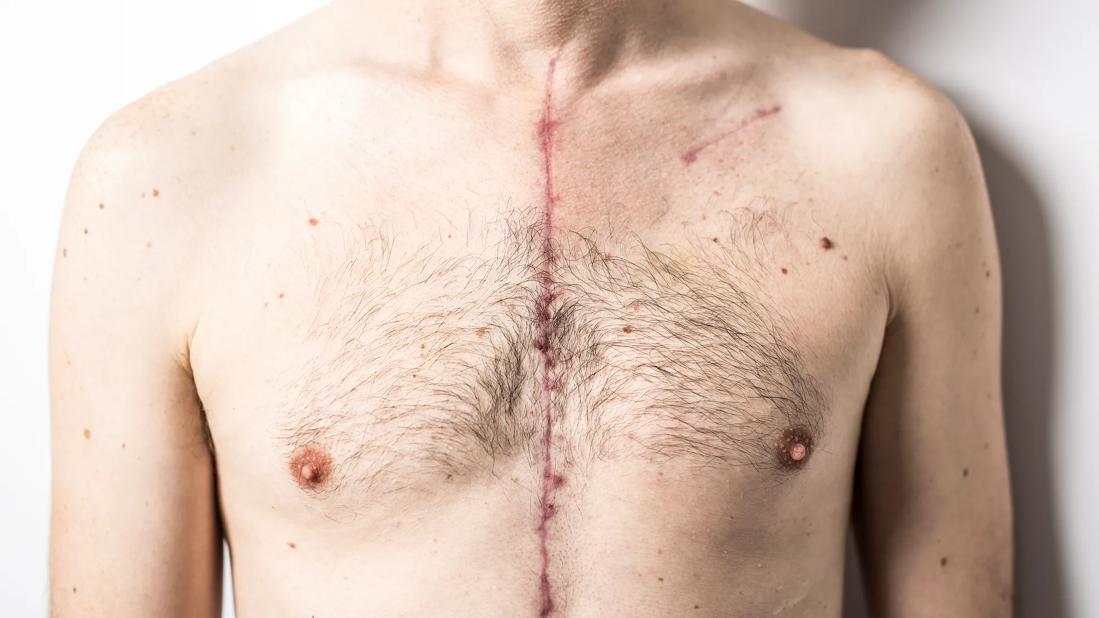How To Care for Your Open-Heart Surgery Scar
Your scar will heal best if you keep the area clean, dry and covered for an appropriate amount of time

Everyone has different relationships with their open-heart surgery scar. Some like to show it off, while others like to keep it close to their chest. Regardless, your scar will always be a part of you in some way.
While a scar from an open-heart surgery is unavoidable, there are forms of aftercare that can help it heal as best as possible.
Types of open-heart surgery scars
The size, location and appearance of your scar depend on the type of heart surgery you have and what incision your surgeon makes, says thoracic and cardiovascular surgeon Tarek Malas, MD.
Open-heart surgery scars are typically caused by:
- Sternotomy:This is the classic vertical incision down the middle of your chest. It splits your breastbone (sternum) and measures about 6 to 8 inches. Procedures that commonly use this incision include valve repair or replacement, heart transplantation and aortic aneurysm repair.
- Upper hemisternotomy:Also known as a mini sternotomy, the scar from this type of heart surgery is caused by a smaller vertical incision in the middle of your breastbone that measures about 3 to 4 inches. Your scar will be smaller than a traditional sternotomy.
- Thoracotomy:Also known as open surgery, this procedure provides access to your thoracic cavity (a hollow space that houses your lungs and heart). A horizontal incision is made along your ribs on either the left or right side of your chest, depending on what organs your surgeon is trying to see. The length of your scar can vary, but it’s typically around 4 to 6 inches.
How to care for your scar
Here are some ways to take care of your scar following heart surgery.
Protect your scar
Your incision will be covered in a bandage while you’re in the hospital and removed by your healthcare provider after a few days. “Usually, you go home without a bandage,” Dr. Malas says.
After that, keep the area covered for two weeks with a small bandage or gauze as your scar starts to heal. Your doctor will give you instructions on how often you need to change your bandage (on average, you’ll need to change your bandage daily).
You also want to protect your scar from sun exposure. Keeping your scar covered will help it heal significantly and prevent any irritation.
Keep the area clean and dry
To prevent infection and promote healing, keep your scar clean and dry. “For the first few weeks, don’t submerge in water or take long baths,” instructs Dr. Malas.
You can clean the area in the shower by using mild soap and warm water — and keep the water pressure low. Don’t pick or scrub at the scar. After, gently pat it dry with a soft towel.
Consider silicone gel
In some cases, your doctor may recommend using a silicone gel or a silicone gel sheet (a soft, flexible adhesive) to help reduce the appearance of your scar, as well as reduce any initial irritation.
Silicone-based gel may help hydrate your scar tissue, flatten raised scars and reduce redness or discoloration. Silicone gel options are available as a prescription or over the counter. But talk with your provider prior to using this treatment strategy, as it’s not recommended for everyone.
To use, simply apply the gel or sheet after cleaning and drying your scar to help it retain moisture. Your doctor may also recommend using additional over-the-counter options like petroleum jelly.
Does a heart surgery scar go away?
Your open-heart surgery scar will heal and change in appearance, but it won’t go away completely. At first, your scar may appear red and thick. But at four to six weeks, you’ll notice that your scar has started to fade and soften.
“It’s after that six-week mark when it starts to fully heal,” Dr. Malas says.
Sometimes, healing can take up to three months. But in most cases, it should look very faint during its final phases of healing.
Dr. Malas also points out that some people may have keloid reactions, which is when your scar continues to grow and becomes larger than the original wound. “In those cases, your scar may remain more visible even after the passing of time,” he says.
Without any treatment, a keloid scar can continue to grow, becoming thicker, lumpy and change from red to brown. If you have a keloid scar, your healthcare provider can discuss treatment options, such as laser therapy or medication.
When to call your doctor
It’s important to follow up with your healthcare provider so they can keep an eye on your scar.
“It’s normal to have a little bit of redness but if the redness worsens, then that could potentially be a sign that you should see your doctor,” states Dr. Malas.
You should immediately see a healthcare provider if you notice:
- A thick liquid or pus coming out of your scar
- Severe redness around the incision area
- The incision area opening
- Chills or a fever over 101 degrees Fahrenheit (38.33 degrees Celsius)
- Pain
“This could be a sign of infection,” he continues. “Sometimes, it’s normal for a scar to have a little bit of straw-colored, clear fluid to come out shortly after surgery. But it should stop with time.”
Key takeaways
Coming home with a scar can feel like a huge change to your body. But remember that, in most cases, it will heal over time and become less visible.
More importantly, make sure to care for your scar and be gentle with it while your body takes its time to heal. And be sure to follow any aftercare recommendations from your healthcare provider or surgeon.